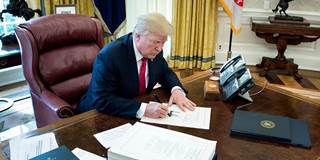OnPoint Subscriber Exclusive
Longer Reads provide in-depth analysis of the ideas and forces shaping politics, economics, international affairs, and more.

What Trump’s Tax Cut Really Means for the US Economy
Republicans and the Trump administration have promised that the tax legislation enacted in December will boost investment and long-term GDP growth. But the new law is likely to do neither, because it is based on flawed assumptions and contains a raft of self-defeating provisions.
AUSTIN – The Trump administration’s stated economic-policy objective is to increase growth in the United States from the post-financial-crisis rate of around 2% to at least 3%. In historical terms, achieving such growth is not out of the question. Real (inflation-adjusted) GDP growth exceeded 3% in 2005-2006 and 4% in the period from 1997 to 2000; and in each of the past two quarters, the economy has grown at an annualized rate above 3%. The question is whether that pace can be sustained.